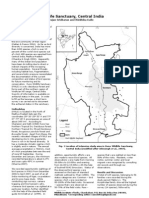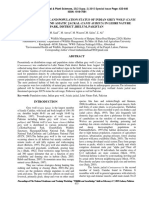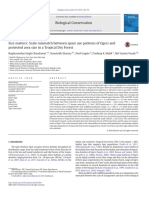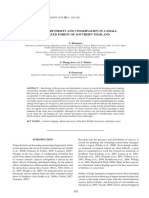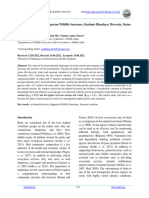Population Density of Indian Giant Squirrel Ratufa Indica Centralis (Ryley, 1913) in Satpura National Park, Madhya Pradesh, India
Population Density of Indian Giant Squirrel Ratufa Indica Centralis (Ryley, 1913) in Satpura National Park, Madhya Pradesh, India
Uploaded by
Raju Lal GurjarCopyright:
Available Formats
Population Density of Indian Giant Squirrel Ratufa Indica Centralis (Ryley, 1913) in Satpura National Park, Madhya Pradesh, India
Population Density of Indian Giant Squirrel Ratufa Indica Centralis (Ryley, 1913) in Satpura National Park, Madhya Pradesh, India
Uploaded by
Raju Lal GurjarCopyright
Available Formats
Share this document
Did you find this document useful?
Is this content inappropriate?
Copyright:
Available Formats
Population Density of Indian Giant Squirrel Ratufa Indica Centralis (Ryley, 1913) in Satpura National Park, Madhya Pradesh, India
Population Density of Indian Giant Squirrel Ratufa Indica Centralis (Ryley, 1913) in Satpura National Park, Madhya Pradesh, India
Uploaded by
Raju Lal GurjarCopyright:
Available Formats
Article Citation:
Raju Lal Gurjar, Amol S. Kumbhar, Jyotirmay Jena, Jaya Kumar Yogesh,
Chittaranjan Dave, Ramesh Pratap Singh and Ashok Mishra.
Population density of Indian giant squirrel Ratufa indica centralis (Ryley, 1913) in
Satpura National Park, Madhya Pradesh, India.
Journal of Research in Biology (2013) 3(7): 1086-1092
J
o
u
r
n
a
l
o
f
R
e
s
e
a
r
c
h
i
n
B
i
o
l
o
g
y
Population density of Indian giant squirrel Ratufa indica centralis (Ryley,
1913) in Satpura National Park, Madhya Pradesh, India
Keywords:
Central Indian landscape, Distance sampling, density estimation, Ratufa
indica centralis.
ABSTRACT:
Information on population and distributional status of Indian giant squirrel
Ratufa indica centralis is poorly known from central Indian hills. The species is
endemic to India and widely distributed in Western Ghats, Eastern Ghats and Central
India. In this study using line transect distance sampling we estimated population
density of giant squirrel in Satpura Tiger Reserve (STR), which is a major biosphere
reserve in central India that harbors wide variety of rare endemic and endangered
species. Density estimate with total effort of 276km line transect shows 5.5 ( 0.82)
squirrels/Km
2
. This study provides first baseline information on ecological density
estimate of Ratufa indica centralis in central Indian landscape. Reduction of
anthropogenic pressure should be the first priority for park managers in Satpura Tiger
reserve.
1086-1092| JRB | 2013 | Vol 3 | No 7
This article is governed by the Creative Commons Attribution License (http://creativecommons.org/
licenses/by/2.0), which gives permission for unrestricted use, non-commercial, distribution and
reproduction in all medium, provided the original work is properly cited.
www.jresearchbiology.com
Journal of Research in Biology
An International
Scientific Research Journal
Authors:
Raju Lal Gurjar
1
,
Amol .S. Kumbhar
1*
,
Jyotirmay Jena
1
,
Jaya Kumar Yogesh
1
,
Chittaranjan Dave
1
,
Ramesh Pratap Singh
2
,
Ashok Mishra
2
.
Institution:
1. WWF - India, Nisha
Building, Near Forest
Barrier, Katra, Mandla,
Madhya Pradesh, India.
2. Field Director Office,
Satpura Tiger Reserve,
Hoshangabad, Madhya
Pradesh, India.
Corresponding author:
Amol S. Kumbhar
Email Id:
Web Address:
http://jresearchbiology.com/
documents/RA0387.pdf.
Dates:
Received: 08 Oct 2013 Accepted: 08 Nov 2013 Published: 25 Nov 2013
Journal of Research in Biology
An International Scientific Research Journal
Original Research
INTRODUCTION
Habitat fragmentation is cited one of the major
reason for the decrease in abundance of arboreal
mammals and isolation of many species into small
population (Umapathy and Kumar, 2000). Indian Giant
Squirrel Ratufa indica centralis is a maroon and buff
colour and is endemic to India with four sub-species. The
conservation status of Indian giant squirrel (IGS) is the
least concern category of IUCN, Appendix II of
CITES and Schedule II (part II) of Indian Wildlife
(Protection) Act 1972 (Molur et al., 2005). Giant
squirrels occur across a wide range of natural forests.
They have been reported from moist deciduous, dry
deciduous and riparian forests (Datta and Goyal, 1996;
Baskaran et al., 2011; Kanoje, 2008; Jathanna
et al., 2008; Srinivas et al., 2008), old mature teak forests
(Ramachandran, 1988) and teak-mixed forests (Kumara
and Singh, 2006). Habitat fragmentation is one of the
major threats which influence giant squirrel population
due to its arboreal nature. Throughout India several
investigators already studied on population status of
Malabar giant squirrel in Western Ghats (Baskaran et al.,
2011; Ramachandran, 1988; Ganesh and Davidar, 1999;
Madhusudan and Karanth, 2002; Kumara and Singh,
2006; Jathanna et al., 2008; Ramesh et al., 2009;
Umapathy and Kumar, 2000). In central India though
there are studies available on ecobiology of Ratufa
indica centralis (Datta, 1993, 1998, 1999; Datta and
Goyal, 1996; Kanoje, 2008; Kumbhar et al., 2012;
Pradhan et al., 2012; Rout and Swain, 2006) but there is
no study available on status and population density of
this species from central Indian landscape.
In the current study we tried to estimate
population densities of Ratufa indica centralis by line
transect distance sampling (Jathanna et al., 2008) in
Satpura Tiger Reserve of central India. It believes that
this kind of effort will help forest department to take
better management and conservation strategies.
MATERIALS AND METHODS
Study area
The Satpura Tiger Reserve (2219 - 22 30N
and 77 56 - 78 20E) covers an area of 1427.87 km
2
(Figure 1) in south east border of Madhya Pradesh state,
it extends from east to west in the southern part of the
district Hoshangabad in Satpura ranges of Central Indian
landscape. The forest types of satpura tiger reserve
consist of southern moist mixed deciduous forest,
southern dry mixed deciduous forest and dry peninsulas
Sal forest (Champion and Seth, 1968). The terrain of
park is hilly and highly undulating, with dominated tree
species such as Tectona grandis, Shorea robusta,
Buchanania latifolia, Terminalia arjuna, Emblica
officinalis, Madhuca indica and Rauwolfia serpentina.
The faunal diversity comprises of major carnivore such
as Tiger (Panthera tigris), Leopard (Panthera pardus),
Dhole (Cuon alpines) and other small carnivores
including Jungle cat (Felis chaus), Palm civet
(Paradoxurus hermaphroditus) as well as ungulates such
as Spotted deer (Axis axis), Sambar (Cervus unicolor),
Wild boar (Sus scrofa), Barking deer (Muntiacus
muntjak), Rhesus macaque (Macaca mulatta) and
Common langur (Semnopithecus entellus). In satpura
birds of prey like crested hawk eagle, black eagle and
crested serpent eagle were major predators of Ratufa
indica centralis (Datta, 1999; Kumbhar et al., 2012).
Also Mehta (1997) reported leopard attempted to prey on
giant squirrel.
Sampling
Line transect methodology was adopted
(Buckland et al., 2001; Jathanna et al., 2008) and
distance sampling methodology was used to estimate
population density of giant squirrel in our study area.
Field sampling was carried out in the months of
December to February 2011 2012. Dur-ing this period
39 permanent transects were established in different
habitat types including riparian patches. Each transect
was surveyed thrice by well trained observer be-tween
Gurjar et al., 2013
1087 Journal of Research in Biology (2013) 3(7): 1086-1092
06000900 hr. Each transects differed in length, the
average transect length was 2km to 4km. Every time the
species was detected group size, sighting distance and
angle of sighting were recorded. Sighting distances were
measured using lesser rangefinder and the angle of
sighting was recorded using a liquid filled compass. The
field protocols were followed described in Jhala et al.,
(2009). The density of Indian giant squirrel (IGS) was
calculated using DISTANCE program version 6.0 (Laake
et al., 1994). The best model was selected on the basis of
the lowest Akaike Information Criteria (AIC) (Burnham
et al., 1980; Buckland et al., 1993).
RESULTS AND DISCUSSION
A total of 35 Giant squirrel sights comprising
42 individuals were recorded during the study period in
total efforts of 276km. Analysis were done by fitting
different detection functions to the observed data for the
estimation of density. Based on minimum AIC value
(94.9), half normal with cosine proved to be the best fit
for giant squirrel data. As giant squirrel is a arboreal
species its visibility is very high when we compare it
with other terrestrial animals so detection in uniform
manner is normal, AIC value also supports the model
selection. The encounter rate was 0.12 0.06/km
walked, IGS known to be a solitary animal, maximum
two individuals were recorded in a group and mean
group size was calculated as 1.2 0.6 in Satpura Tiger
Reserve.
Studies conducted elsewhere on Indian Giant
Squirrel (IGS) have shown different estimates of
population density (Table. 2). The variation in different
Gurjar et al., 2013
Journal of Research in Biology (2013) 3(7): 1086-1092 1088
Figure 1: Location of Satpura Tiger Reserve in India.
estimates in different studies could be due to the different
habitat types in the different study areas; also seasonal
annual variation and observer differences put limits of
comparison. The present study is the first attempt to
provide baseline information on ecological density status
of Indian giant squirrel in Central Indian landscape
(Table. 1). IGS distribution in STR was observed in
Terminalia arjuna, Madhuca longifolia and Tectona
grandis. These trees are mostly used for feeding and
nesting (Kumbhar et al., 2012). Maximum IGS sightings
were recorded in riparian patches of churna, moist and
dry deciduous forest of watch tower and semi-evergreen
forest of Nimghan to pachmarhi. A viable population is
one that maintains its genetic vigor and potential for
evolutionary adaptation (Kumar et al., 2007), therefore
continuous monitoring of the population status of this
lesser-known mammal in central India should be given
high conservation priority. Excessive amount of
Gurjar et al., 2013
1089 Journal of Research in Biology (2013) 3(7): 1086-1092
D
e
t
e
c
t
i
o
n
P
r
o
b
a
b
i
l
i
t
y
Figure 2: Result of model fitted in the DISTANCE to estimate detection probability and effective
strip width of giant squirrel in Satpura Tiger Reserve.
Perpendicular distance in meters
Note: DS- estimate average group size; E(S) estimate expected value of cluster size; D estimate of density of
animal; N estimate no. of animals in specified area; Chi-square value P 0.969.
Table 1: Population density and average group size of Indian Giant Squirrel
(density /Km
2
) estimated in Satpura Tiger Reserve.
Parameter Point Estimate Standard Error Percentage Coefficient
of variation
95% Confidence Interval
DS 4.786 0.66 13.83 3.62 6.31
E(S) 1.169 0.59 5.05 1.05 1.29
D 5.595 0.82 14.73 4.17 7.49
N 6.000 0.88 14.73 4.00 7.00
poaching pressure and habitat fragmentation has been
reported in Orissa (Pradhan et al., 2012) which can leads
to population decline. We hope this baseline study will
encourage long-term study, which includes on nesting
breeding habits and resource availability of IGS
populations in Central Indian Forest. Further research
study about population status for this species and
conservation strategies in the central Indian landscape
are recommended.
CONCLUSION:
The present population density of Indian giant
squirrel 5.5 0.8 / Sq Km in Satpura tiger reserve in
central Indian forest is very important as it is first density
estimates from any central Indian forest and will provide
baseline data for future study. Present study is address
the issue of urgent need of survey the status, distribution
and abundance of Indian giant squirrel in central Indian
landscape.
ACKNOWLEDGE:
We are really grateful to Ravi Singh, Secretary
General and CEO, WWF-India and Principal Chief
Conservator of Forest (Wildlife), Chief Wildlife Warden,
Madhya Pradesh for give permission to conduct
phase-IV monitoring of predators and their prey in
Satpura Tiger Reserve. We would like to acknowledge
frontline staff of Satpura tiger reserve, Ratnesh and
Kamal Thakur for their extensive help in field work.
REFERENCES:
Baskaran N, Venkatesan S, Mani J, Srivastava SK
and Desai AA. 2011. Some aspects of the ecology of the
Indian Giant Squirrel Ratufa indica (Erxleben, 1777) in
the tropical forests of Mudumalai Wildlife Sanctuary,
sout her n Indi a and t hei r conser vat i on
implications. Journal of Threatened Taxa, 3(7): 1899
1908.
Borges R, Mali RS and Somanathan H. 1999. The
status, ecology and conservation of the Malabar Giant
Squirrel Ratufa indica. Final report. United States Fish
and Wildlife Service and Wildlife Institute of India.
Borges R. 1989. Resource heterogeneity and the
foraging ecology of the Malabar Giant Squirrel (Ratufa
indica). PhD Thesis, University of Miami, Florida.
Gurjar et al., 2013
Journal of Research in Biology (2013) 3(7): 1086-1092 1090
Table 2: Density of Indian Giant Squirrel (individual/Km
2
) from other part of India.
Study site Density of IGS /Sqkm Authors
Anamalai Hills 11.4 - 64 Umapathy and Kumar 2000
Kudremukh NP 0.25 Madhusudan and Karanth 2002
Bandipur TR 2.36
Jathanna et al., 2008
Nalkeri 4.55
Sunkadakatte 4.86
Muthodi 10.19
Lakkavalli 12.25
Madumalai TR
2.9 Baskaran et al., 2011
1.6 Ramesh et al.,2009
Kalakad-Mudanthurai TR 1.7 Ramesh et al., 2012
Kakachi 1.42 Ganesh and Davidar 1999
Bhimashankar W Sanctuary
12.4 Borges et al.,1999
15.89 Mehta et al.,2012
Buckland ST, Anderson DR, Burnham KP and Laake
JL. 1993. Distance Sampling: Estimating abundance of
biological populations. Chapman and Hall, London. 446.
Buckland ST, Anderson DR, Burnham KP, Laake
JL, Borchers DL and Thomas L. 2001. Introduction to
distance sampling: Estimating Abundance of Biological
Populations. Oxford University Press, Oxford, UK. 432.
Burnham KP, Anderson DR and Laake JL 1980.
Estimation of density from line transect sampling of
biological populations, Wildlife Monographs, 72: 1-202.
Champion HG and Seth SK 1968. A Revised Survey of
the Forest Types of India. Oxford & IBH Publishers,
New Delhi.
Datta A. 1993. Space-use patterns of the Indian giant
squirrel (Ratufa indica) in relation to food availability in
Bori Wildlife Sanctuary, Madhya Pradesh, India. M.Sc.
thesis submitted to Saurashtra University.
Datta A and Goyal SP. 1996. Comparison of Forest
Structure and Use by the Indian Giant Squirrel (Ratufa
indica) in Two Riverine Forests of Central India.
Biotropica, 28 (3), 394399.
Datta A. 1998. Anti-predatory response of the Indian
giant squirrel Ratufa indica to predation attempts by the
Crested Hawk Eagle Spizaetus cirrhatus limnaetus.
Journal of Bombay Natural History Society, 95(2): 332
335.
Datta A. 1999. Daytime resting in the nest An
adaptation by the Indian giant squirrel Ratufa indica to
avoid predation. Journal of Bombay Natural History
Society, 96, 132 134.
Ganesh T and Davidar P. 1999. Fruit Biomass and
Relative Abundance of Frugivores in a Rain Forest of
Southern Western Ghats, India, Journal of Tropical
Ecology, 15 (4), 399-413.
Jathanna D, Kumar NS and Karanth KU. 2008.
Measuring Indian giant squirrel (Ratufa indica)
abundance in southern India using distance sampling,
Current Science, 95(7): 885-888.
Jhala YV, Qureshi Q, Gopal R and Amin R. 2009.
Field Guide: Monitoring tigers, co-predators, prey and
their habitats. Third ed. Technical publication of
National Tiger Conservation Authority, New Delhi and
the Wildlife Institute of India, Dehradun.
Kanoje RS. 2008. Nesting sites of Indian Giant Squirrels
in Sitanadi Wildlife Sanctuary, India, Current Science,
95 (7): 882 884.
Kumara HN and Singh M. 2006. Distribution and
relative abundance of giant squirrels and flying squirrels
in Karnataka, India, Mammalia. 70(1-2): 40-47.
Kumar S, Agoramoorthy G and Hsu MJ. 2007.
Population size, density and conservation status of the
grizzled giant squirrel in Chinnar Wildlife sanctuary,
India. Mammalia. 70(1-2): 89 94.
Kumbhar A, Pradhan A and Patwardhan G. 2012.
Some observation on dray building and jumping
behavior of Indian Giant Squirrel Ratufa indica
(Erxleben, 1777). Universal Journal of Environmental
Research and Technology, 2(4): 366 368.
Laake JL, Buckland ST, Anderson DR and Burnham
KP. 1994. DISTANCE: users guide V2.1. Colorado
Cooperative Fish and Wildlife Research Unit, Colorado
State University, Fort Collins, USA.
Madhusudan MD and Karanth KU. 2002. Local
Hunting and the Conservation of Large Mammals in
India, Ambio, 31(1): 49-54.
Mehta P, Kulkarni J, Pawar T, Sahoo RK, Arulmalar
E and Punjabi G. 2012. Status and Distribution of
Malabar Giant Squirrel Ratufa indica in Western Ghats
of Maharashtra, India. Wildlife Research and
Gurjar et al., 2013
1091 Journal of Research in Biology (2013) 3(7): 1086-1092
Submit your articles online at www.jresearchbiology.com
Advantages
Easy online submission
Complete Peer review
Affordable Charges
Quick processing
Extensive indexing
You retain your copyright
submit@jresearchbiology.com
www.jresearchbiology.com/Submit.php.
Conservation Society, Pune. Final Technical Report
submitted to WWF New Delhi and Ruffords Small
Grants Program, United Kingdom. 74.
Mehta P. 1997. Leopard (Panthera pardus) attempting
to prey on Indian giant squirrel (Ratufa indica centralis).
Journal of Bombay Natural History Society, 94: 555-556.
Molur S, Srinivasulu C, Srinivasulu B, Walker S,
Nameer PO and Ravikumar L. 2005. Status of South
Asian Non-volant Small Mammals: (C.A.M.P.)
Workshop Report. Zoo Outreach Organisation/CBSG-
South Asia, Coimbatore, India, 618 p.
Pradhan AK, Shrotriya S and Rout SD. 2012.
Observation on Nest- Site selection by Indian giant
squirrel in Karlapat Wildlife Sanctuary, Odisha, Small
Mammal Mail, 4(2):12-13.
Ramesh T, Snehalatha V, Sankar K and Qureshi Q.
2009. Food habits and prey selection of tiger and leopard
in Madumalai Tiger Reserve, Tamil Nadu, India. Journal
of Scientific Transaction in Environment and
Technovation, 2(3): 170 181.
Ramesh T, Sridharan N, Sankar K, Qureshi Q,
Selvan KM, Gokulakkannan N, Francis P,
Narasimmarajan K, Jhala YV and Gopal R. 2012.
Status of large carnivores and their prey in tropical rain
forests of South-Western Ghats, India. International
society of Tropical Ecology, 53 (2): 137 148.
Ramachandran KK. 1988. Ecology and Behaviour of
Malabar Giant Squirrel, Ratufa indica maxima
(Schreber), Kerala Forest Research Institute, P 18.
Rout SD. and Swain D. 2006. The Giant Squirrel
(Ratufa indica) in Similipal Tiger Reserve, Orissa, India.
Tiger paper. 33(4): 24-27.
Srinivas V, Venugopal PD and Ram S. 2008. Site
occupancy of the Indian giant squirrel Ratufa indica
(Erxleben) in KalakadMundanthurai Tiger Reserve,
Tamil Nadu, India. Current Science, 95 (7): 889-894.
Umapathy G and Kumar A. 2000. The occurrence of
arboreal mammals in the rain forest fragments in the
Anamalai Hills, south India, Biological Conservation, 92
(3): 311-319.
Journal of Research in Biology (2013) 3(7): 1086-1092 1092
Gurjar et al., 2013
You might also like
- (2020-2021) (Olympic Tháng 4 Lớp 11) (With Suggested Key) Đề thi OT4 TPHCM mở rộng năm 2021 kèm đáp án tham khảoDocument6 pages(2020-2021) (Olympic Tháng 4 Lớp 11) (With Suggested Key) Đề thi OT4 TPHCM mở rộng năm 2021 kèm đáp án tham khảoWilliam Phoenix60% (5)
- Assessment and Control of Hard Waste in Spinning Mill'Document44 pagesAssessment and Control of Hard Waste in Spinning Mill'chavanhrishi1488% (8)
- Machine Tool Vibration and DampersDocument42 pagesMachine Tool Vibration and DampersLuis NunesNo ratings yet
- Sustaible - The Wall HouseDocument12 pagesSustaible - The Wall HousePrakhar JainNo ratings yet
- Density of The Indian Peafowl Pavo Cristatus in Satpura Tiger Reserve, IndiaDocument7 pagesDensity of The Indian Peafowl Pavo Cristatus in Satpura Tiger Reserve, IndiaRaju Lal GurjarNo ratings yet
- Red Giant Flying Squirrel (Petaurista Petaurista) in Assam, IndiaDocument4 pagesRed Giant Flying Squirrel (Petaurista Petaurista) in Assam, Indiaanon_534718533No ratings yet
- Bannerghatta Report 2019Document26 pagesBannerghatta Report 2019Anagha GaNaNo ratings yet
- Herpetofaunal Diversity at Navegaon National Park, Distt. GondiaDocument8 pagesHerpetofaunal Diversity at Navegaon National Park, Distt. GondiaESSENCE - International Journal for Environmental Rehabilitation and ConservaionNo ratings yet
- ButterflyDocument13 pagesButterflyprosenjeet layekNo ratings yet
- Diversity of Lizards Reptilia Sauria of Gandhamardan Hills Range of Western Orissa India PDFDocument6 pagesDiversity of Lizards Reptilia Sauria of Gandhamardan Hills Range of Western Orissa India PDFSzabina HorváthNo ratings yet
- Kuno Birds by T. RameshDocument5 pagesKuno Birds by T. RameshTharmalingam RameshNo ratings yet
- Diversity of Lizards (Reptilia: Sauria) of Gandhamardan Hills Range of Western Orissa, IndiaDocument7 pagesDiversity of Lizards (Reptilia: Sauria) of Gandhamardan Hills Range of Western Orissa, IndiaSzabina HorváthNo ratings yet
- Distribution Range and Population Status of Indian Grey WolfDocument8 pagesDistribution Range and Population Status of Indian Grey WolfMohammad SalimNo ratings yet
- Winter Avian Population of River Brahmaputra in Dibrugarh, Assam, IndiaDocument3 pagesWinter Avian Population of River Brahmaputra in Dibrugarh, Assam, IndiaUtpal Singha RoyNo ratings yet
- Tiger and Leopard Density by T. RameshDocument10 pagesTiger and Leopard Density by T. RameshTharmalingam RameshNo ratings yet
- Scale Mismatch Between Space Use Patterns of Tigers and PDFDocument8 pagesScale Mismatch Between Space Use Patterns of Tigers and PDFRidwan GuntoroNo ratings yet
- Floral Diversity of Gudekote Bear Sanctuary With Reference To Feeding Ecology of Sloth BearsDocument10 pagesFloral Diversity of Gudekote Bear Sanctuary With Reference To Feeding Ecology of Sloth BearsDr Samad KotturNo ratings yet
- Density and Distribution of Indian PeafowlDocument6 pagesDensity and Distribution of Indian PeafowlNavonil DasNo ratings yet
- Megamalai - Biodiversity Srinivas Et AlDocument7 pagesMegamalai - Biodiversity Srinivas Et Alyappanpalani5123No ratings yet
- Diversity of Dragonflies Insecta Odonata in A DeciDocument7 pagesDiversity of Dragonflies Insecta Odonata in A DeciSyed Ghassan AzharNo ratings yet
- Ecology and Behavior of Assamese Monkeys in Shivapuri Nagarjun National Park, NepalDocument13 pagesEcology and Behavior of Assamese Monkeys in Shivapuri Nagarjun National Park, NepalPratik KafleNo ratings yet
- Mishra Shashi IndianJournalofEcology 114 119Document7 pagesMishra Shashi IndianJournalofEcology 114 119bharath ugNo ratings yet
- On_the_spider_diversity_of_Salbardi_foreDocument4 pagesOn_the_spider_diversity_of_Salbardi_foreppsprudence22No ratings yet
- Status of Tigers in India 2008Document164 pagesStatus of Tigers in India 2008Syed Aiman RazaNo ratings yet
- FT-2014-PR-125Document35 pagesFT-2014-PR-125arithansasiNo ratings yet
- Review Butterflies... Parandhaman Durairaj Et Al1Document18 pagesReview Butterflies... Parandhaman Durairaj Et Al1kaedehara.kazuha.belleNo ratings yet
- Nair Krishna JoTT 2013Document23 pagesNair Krishna JoTT 2013geoheritage.sbicapsNo ratings yet
- Status of Tigers in 24 Parganas South Forest Division 08-10-12Document50 pagesStatus of Tigers in 24 Parganas South Forest Division 08-10-12TinkuBabaNo ratings yet
- NeBIO 1 3 Soud Et AlDocument1 pageNeBIO 1 3 Soud Et AlneceerNo ratings yet
- Tiger Status Report - 2018Document40 pagesTiger Status Report - 2018Samrat MazumdarNo ratings yet
- Diversity and Guild Structure of Spider Fauna at Sawanga-Vithoba Lake (Malkhed Project) Area in Pohara Forest Dist Amravati, Maharashtra, IndiaDocument10 pagesDiversity and Guild Structure of Spider Fauna at Sawanga-Vithoba Lake (Malkhed Project) Area in Pohara Forest Dist Amravati, Maharashtra, IndiaTJPRC PublicationsNo ratings yet
- Bird Diversity of Narmada Wetland Area and ItsDocument8 pagesBird Diversity of Narmada Wetland Area and ItsShailendra YadavNo ratings yet
- 41 Mammalia-8Document12 pages41 Mammalia-8Senia radaNo ratings yet
- AnimalDocument5 pagesAnimalrodrigokine777No ratings yet
- Status Leopard India 2018Document40 pagesStatus Leopard India 2018pavan100% (1)
- Acridids As Indicators of Disturbance in Dry Deciduous Forest of West Bengal in IndiaDocument8 pagesAcridids As Indicators of Disturbance in Dry Deciduous Forest of West Bengal in IndiaRichard MooreNo ratings yet
- Status Tigers India Summary 2018Document40 pagesStatus Tigers India Summary 2018Raghav SinghNo ratings yet
- ART20176831Document6 pagesART20176831SrikumarNo ratings yet
- Abundance and Distribution of Tiger Prey Base at Bardia-Katarniyaghat Corridor Forest, NepalDocument4 pagesAbundance and Distribution of Tiger Prey Base at Bardia-Katarniyaghat Corridor Forest, NepalSAVAGE BATTLENo ratings yet
- Jahangger Et Al We JournalDocument11 pagesJahangger Et Al We JournalJahangeer KhushikhlaqNo ratings yet
- Avian Diversity at Prashnavada Wetland, Gir-Somnath District, Gujarat, IndiaDocument10 pagesAvian Diversity at Prashnavada Wetland, Gir-Somnath District, Gujarat, IndiaTJPRC PublicationsNo ratings yet
- YamunaSurveyReport 2023Document40 pagesYamunaSurveyReport 2023swetan anandNo ratings yet
- 18 JMR 2022 Adaal - OkDocument15 pages18 JMR 2022 Adaal - OknatureblossomingNo ratings yet
- A Check List of Important Mammalian Species Observed in and Around Chilkiya-Kota Elephant (Dhangari-Sunderkhal)Document4 pagesA Check List of Important Mammalian Species Observed in and Around Chilkiya-Kota Elephant (Dhangari-Sunderkhal)AG AnsariNo ratings yet
- Paper On Turtles of TOCR 2021Document5 pagesPaper On Turtles of TOCR 2021samad66No ratings yet
- Crouching Tigers Hidden Prey Sumatran Tiger and PRDocument10 pagesCrouching Tigers Hidden Prey Sumatran Tiger and PRDuta AdityaNo ratings yet
- Conservation Status of Bengal Tiger (Panthera: Tigris Tigris) - A ReviewDocument5 pagesConservation Status of Bengal Tiger (Panthera: Tigris Tigris) - A ReviewDebraj DattaNo ratings yet
- Ahmed Et Al. 2009Document30 pagesAhmed Et Al. 2009Priyanka BorahNo ratings yet
- Avian Diversity of Basai Wetlands, HaryanaDocument10 pagesAvian Diversity of Basai Wetlands, HaryanaVipin BooraNo ratings yet
- Study On Avifaunal Diversity From Three Different Regions of North Bengal, IndiaDocument11 pagesStudy On Avifaunal Diversity From Three Different Regions of North Bengal, Indiayatankumar424No ratings yet
- Sloth Bear Habitat Akhtar Bargali 15 2Document9 pagesSloth Bear Habitat Akhtar Bargali 15 2Sabyasachi RathNo ratings yet
- 052.025.0102Document7 pages052.025.0102vishnutiwari1502No ratings yet
- 21 Paper RahulDocument13 pages21 Paper RahulShambhu Nath MishraNo ratings yet
- Vascular plant diversity in Doon University CampusDocument21 pagesVascular plant diversity in Doon University CampusAmber SrivastavaNo ratings yet
- Assessment of Seasonal and Altitudinal Variation in Population Density and Biomass of BeetlesDocument12 pagesAssessment of Seasonal and Altitudinal Variation in Population Density and Biomass of BeetlesJournal of Environment and Bio-SciencesNo ratings yet
- Avifaunal Diversity of Baisipali Wildlife SancturyDocument3 pagesAvifaunal Diversity of Baisipali Wildlife SancturyRashmi PatraNo ratings yet
- Rasmussen2013 11928 IndiaDocument29 pagesRasmussen2013 11928 IndiaguediaurichNo ratings yet
- Entomofauna of Kane Wildlife Sanctuary, Arunachal Pradesh, Northeastern IndiaDocument9 pagesEntomofauna of Kane Wildlife Sanctuary, Arunachal Pradesh, Northeastern IndiaSubhradeb PramanikNo ratings yet
- Patkarchavan IJSRDocument5 pagesPatkarchavan IJSRpappuNo ratings yet
- Bird Indian RollerDocument7 pagesBird Indian RollerMuhammad Talha ImtiazNo ratings yet
- Plants From Pitlakes: An inventory of plants from the pitlakes of Eastern Coalfields, IndiaFrom EverandPlants From Pitlakes: An inventory of plants from the pitlakes of Eastern Coalfields, IndiaNo ratings yet
- Low Cost TechniquesDocument24 pagesLow Cost TechniquesAkanksha Rajput100% (1)
- Theories of Cummunication by Mary MunterDocument6 pagesTheories of Cummunication by Mary MunterShabbirAhmadNo ratings yet
- English MLM (1st Year)Document153 pagesEnglish MLM (1st Year)Pranav AdithyaNo ratings yet
- Chapter 7 Man and EnvironmentDocument12 pagesChapter 7 Man and EnvironmentShinya KogamiNo ratings yet
- Uncertainty Reduction TheoryDocument11 pagesUncertainty Reduction TheoryNicole PalomaresNo ratings yet
- 5393Where can buy Civilizing nature national parks in global historical perspective 1st Edition Bernhard Gissibl Sabine Hohler Patrick K Kupper Eds ebook with cheap priceDocument27 pages5393Where can buy Civilizing nature national parks in global historical perspective 1st Edition Bernhard Gissibl Sabine Hohler Patrick K Kupper Eds ebook with cheap pricemendexguoguo30100% (1)
- Essay of Environmental Fiction: The Depiction of Language in Margaret Atwood's Surfacing and Jane Urquhart's A Map of GlassDocument13 pagesEssay of Environmental Fiction: The Depiction of Language in Margaret Atwood's Surfacing and Jane Urquhart's A Map of GlassJulls76No ratings yet
- Boundary of The Pucara BasinDocument5 pagesBoundary of The Pucara BasinManuel ElescanoNo ratings yet
- Theme Statement Sheet - SympathyDocument2 pagesTheme Statement Sheet - Sympathyapi-263744910No ratings yet
- AI BookDocument508 pagesAI BookYoga TuwekNo ratings yet
- General Specification - Roads and BridgesDocument165 pagesGeneral Specification - Roads and BridgesEnea BogdanNo ratings yet
- Forest Lakes Launch PDFDocument130 pagesForest Lakes Launch PDFsalsalah161No ratings yet
- Red PandaDocument24 pagesRed PandaDaphne Tan 丽文50% (2)
- Week 8 Reflective JournalDocument4 pagesWeek 8 Reflective Journalapi-254702147No ratings yet
- Isopan Man Tecnico GBDocument76 pagesIsopan Man Tecnico GBSergiu StanciuNo ratings yet
- Land Use and PlnningDocument33 pagesLand Use and PlnningRahul KhumkarNo ratings yet
- Mixed Conjunctions Test 9 - GrammarBankDocument4 pagesMixed Conjunctions Test 9 - GrammarBankOla GabrNo ratings yet
- Carnivore Web Site - BrugalsDocument11 pagesCarnivore Web Site - BrugalsMwenda WahomeNo ratings yet
- All Question PapersDocument12 pagesAll Question Papersvenkatrao_100No ratings yet
- Environment Law AssignmentDocument35 pagesEnvironment Law AssignmentAnna OommenNo ratings yet
- Numerical Simulation of The Dynamic Operation of Multi-Outlet Siphonic Roof Drainage SystemsDocument12 pagesNumerical Simulation of The Dynamic Operation of Multi-Outlet Siphonic Roof Drainage SystemsDuzzysNo ratings yet
- Annotated BibliographyDocument5 pagesAnnotated Bibliographyapi-310199692No ratings yet
- 1995 Abensperg TraunDocument7 pages1995 Abensperg TraunevalleucoNo ratings yet
- BioC.4-Conservation of BiodiversityDocument27 pagesBioC.4-Conservation of BiodiversityMohammad HamdanNo ratings yet
- Humans Are Animals, and Animals Are HumansDocument6 pagesHumans Are Animals, and Animals Are HumansDiZzy IbrahimNo ratings yet
- All Student Activities For Ipad '24Document36 pagesAll Student Activities For Ipad '24liacaver21No ratings yet










